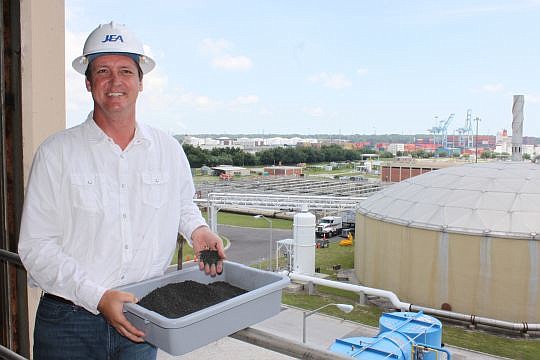
Down the sink and the water is gone. Toilets, washing machines and bathtubs, too.
Most people probably don’t stop to consider what happens after their used, dirty water leaves their sight.
Casey Nettles and the 35 or so workers at the Talleyrand Wastewater Treatment Facility think about it, though. It’s their job to ensure it’s cleaned, re-cleaned and safe to place into the St. Johns River. The largest wastewater treatment facility in the area has water flowing its way 24 hours a day, seven days a week, 365 days a year.
“The flow of the water never stops,” said Nettles, the manager of the facility.
Years ago, not as much attention was paid to wastewater. After a onceover, it went to the river.
Later came chemicals, mainly chlorine, used to better treat the effluent.
Those were phased out more than a decade ago in favor of more natural cleaning methods, such as bacteria and ultraviolet lights used today.
The steps through which water enters the plant before leaving resembles an obstacle course.
First, it’s the large debris that’s captured. Children’s toys, a rubber snake, toys, false teeth, even an artificial eye, which is what Nettles says is the strangest item that’s come through in his time there. That also includes the time a bowling ball showed up. How did it fit?
“That’s a good question,” he said, with a laugh.
And it’s not just using a net or adding a dose of a formula to make the rest magically cleaner. There’s the need to remove sand followed by a series of chambers that introduce bacteria and oxygen to help the cleaning process, before ultimately ending up filtering through 4,000-watt ultraviolet bulbs.
In addition to wastewater treatment, there’s also a biosolids facility that uses byproduct, affectionately called sludge, to create fertilizer sold to a company. The fertilizer pellets are created on-site and the revenue helps offset Buckman’s expenses, which can be massive. Nettles estimates it’s about $1 million annually in electric costs.
Born and raised in the Space Coast area of Florida, Nettles moved to Jacksonville for a position with JEA and worked his way up to the management position he currently holds. And while some might cringe at the concept or the idea of the smell, working at a facility like Buckman is something Nettles says he always wanted to do because of the importance of the job.
“Every day is something new … you have to stay on your toes,” he said.
Especially when people dump potentially toxic materials, like 55 gallons of industrial detergent as someone did years ago did. Nettles said the result was the facility turning into “a giant bubble bath.”
“Buckman Street is one of a kind,” he said.
@writerchapman
(904) 356-2466